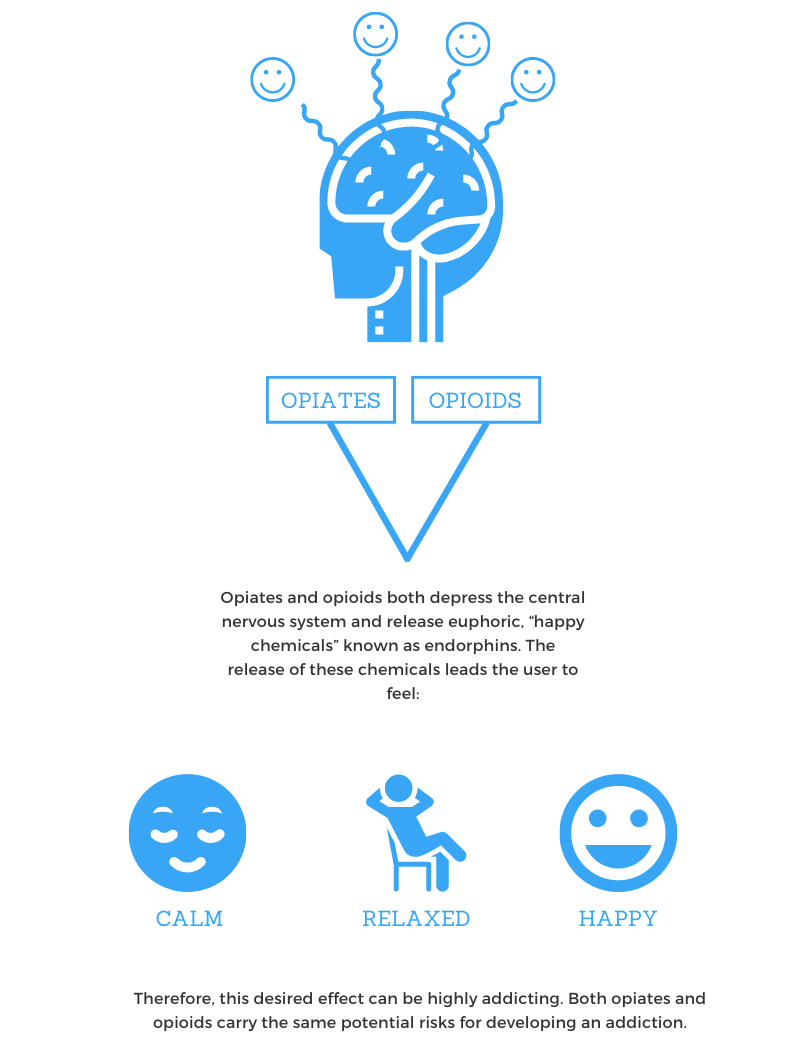Opiates are some of the oldest known drugs in the world. Derived from alkaloid compounds in the opium poppy plant, the history of opiates has reached several continents over the span of centuries. These drugs are clinically used for the treatment of mild to severe pain. Often referred to as “opioid painkillers”, the calming and euphoric effects of opiates predispose the user to abuse and ultimately increases the chances of developing an opiate addiction.
Opioids vs Opiates
Before we discuss the different types of opiates, it is important to address the questions surrounding opioids and opiates. Both of these terms are often used interchangeably because these substances produce the same effects.
- Opiates – Opiates contain active ingredients derived from the opium poppy plant. Common opiates include:
- Opium
- Morphine
- Heroin
- Codeine
- Opioids – The term opioids refers to synthetic or partially synthetic drugs that produce a similar effect to an opiate. Common opioids include:
- Percocet
- Vicodin
- Oxycodone
- Methadone

Types of Opiates
When discussing specific types of opiates, there are two main classifications for this drug – antagonists and agonists. Agonists are drugs that activate certain receptors in the brain and mimic the effects of naturally-occurring endorphins in the brain and body. These drugs produce a euphoric effect and are highly addictive. Antagonists are drugs that block opioids by attaching to the receptors without actually activating them. For example, Naloxone is a drug that is sometimes used to reverse a heroin overdose or assist with opiate detox.
The most common opiate agonists are:
- Codeine – Codeine is most commonly prescribed to reduce mild to moderate pain and coughing. Although this opiate is less potent, it still poses a potential for abuse. Young adults often create a mixture with juices or other sugary drinks to create a drink referred to as “purple drank” or “syrup”.
- Demerol – Demerol is used to treat moderate to severe pain. This narcotic is less frequently prescribed due to its highly addictive components.
- Dilaudid – Dilaudid is a powerful painkiller that is often referred to as “hospital grade heroin”. Due to its euphoric effects, Dilaudid is commonly abused and can ultimately lead to respiratory failure or death.
- Fentanyl – Fentanyl is a synthetic painkiller that is 50 times more potent than heroin and 100 times more potent than morphine. This narcotic is only prescribed for patients experiencing extreme pain. Fentanyl has become a part of the major epidemic facing many Americans today. The drug is often added to other drugs to increase potency and the desired effect. A small amount of Fentanyl can lead to overdose and death.
- Hydrocodone – Hydrocodone is found in many prescription painkillers and is typically combined with acetaminophen or ibuprofen.
- Methadone – Methadone is used for moderate to severe pain. However, this opioid is most commonly used for helping individuals who are addicted to other substances such as heroin. Despite its potentially helpful properties, methadone can still pose a risk for potential abuse and overdose.
- Morphine – The narcotic Morphine is used to treat individuals suffering from severe chronic pain. This specific opioid is one of the most highly abused and potentially deadly drugs nationwide.
- Oxycodone – Oxycodone is a widely prescribed painkiller and is sold under different brand names such as Percocet or OxyContin.
The Cycle of Opiate Tolerance, Dependence, and Addiction
Oftentimes, individuals are prescribed opiate medication for pain following an accident, injury, or chronic pain diagnosis. Just like with any other prescription medication, the doctor will specify a dose. Patients may have no intention of ever abusing the prescription. However, a tolerance to the painkillers will begin to develop and the individual may feel the drug is no longer effective. Tolerance often leads to an individual taking larger than the prescribed dose in order to achieve the desired effects.
Increasing the dosage of opiates can eventually lead to dependence. Once an individual has developed a dependence on opiates, they need to continue taking the drug to feel normal. Furthermore, dependence leads to cravings, which are extreme urges to continue using a substance despite negative consequences.
Eventually, the cycle of opiate addiction begins to wreak havoc on the life of the user and the loved ones around them. Once an individual has become a full-blown addict, their physical and psychological health will experience a total hijacking by the opiates abused. Addiction is a neurological disease that leaves the individual feeling hopeless of ever escaping this vicious cycle, despite its potentially fatal effects. The only way an individual can fully recover from the grips of opiate addiction is by seeking treatment at an inpatient rehabilitation center.













